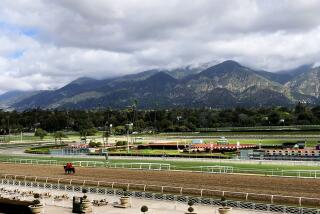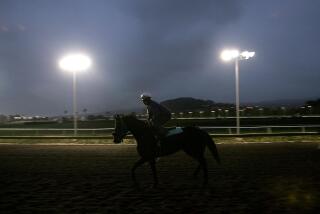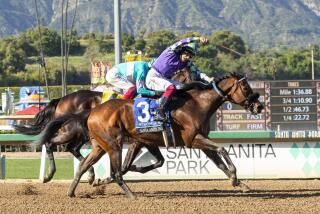COMMENTARY : Workout Disinformation Must Come to an End
- Share via
As if the attempt to predict the winner of a horse race were not difficult enough, the presence of two groups of clockers working independently at New York tracks has resulted in an unintentional cry for the state to take over the timing of morning workouts.
Workout information has always been the subject of criticism at tracks where the Daily Racing Form’s clockers were the only source. Most handicappers have accepted the fact that the clockers will put one away now and then. Many clockers consider the selected mistiming of works an inalienable right of people whose day begins at 5 a.m. Eventually, when the money shows for a first-time starter or a neophyte coming to hand in hidden morning trials, the handwriting appears plainly on the tote board.
We now have two groups of clockers working side by side at New York tracks, timing the same horses with results so dissimilar that dealing with workout information has become impossible. The differences in recent workout data run the gamut from compellingly subtle to completely inscrutable, and the result is that all such current information must be considered suspect no matter from which racing paper it comes.
Case in point: Turnback The Alarm, who won the fourth race at Belmont Park Wednesday in her debut. The Racing Form showed a 3-furlong work June 22 in :36 2-5 handily, which would indicate the filly was being urged through the stretch in a rather mundane effort. On June 18, according to the Form clockers, she went a half-mile in :49 1-5, breezing, which would indicate she was being allowed to run on her own through the stretch in an ordinary move. The Form shows two other workouts, both quite unremarkable and recorded since the Racing Times began its clocking operation here. Both are missing from Turnback The Alarm’s workout line in the Racing Times, however.
The filly portrayed in two Racing Times workouts is substantially quicker than the Racing Form’s version of Turnback The Alarm. The Racing Times has her in :35.74 (it times in hundredths rather than fifths of seconds), breezing, on June 22, a move that would demand a handicapper’s attention. The previous work, a half-mile in :48.80 breezing, is only a shade faster than the Form’s time. But most handicappers would prefer to see a longer work by a first-timer. A gate work would have been even more interesting. Such a work, 1:01 1-5 handily June 10, appears in the Form, but not the Times. Though the Form’s time does not indicate she is particularly fast, the fact she worked the longer distance from the gate is important. The discrepancies in her two most recent works raise the question of whether she is faster than her Form works would indicate. It may be impossible to determine which data is accurate, but it is certain that neither is presenting a completely accurate picture of a filly who won by 16 1/2 lengths and paid $9.60. The money showed.
Were this an isolated case, such discrepancies could be viewed as pieces of the puzzle, the solving of which is rewarded at the windows for those who purchased both the world’s most expensive dailies at a cost of $5 per day. But this is only the most subtle of cases. Comparing the workout data in the Form and Racing Times leaves the impression that someone here is attempting either to disinvent the wheel or invent an over-the-counter capsule that gives you a headache.
PC’s Glory was scratched from Thursday’s ninth race, eliminating the need for handicappers to puzzle over their workout lines until he next appears in the entries. It is only a reprieve.
According to the Racing Form, PC’s Glory has had three recent works in anticipation of his career debut. The last was a slow 6 furlongs June 2 at Aqueduct, the penultimate a slow 5-furlong breeze, preceded by a bullet 5-furlong work from the gate on May 16, 1:01 3-5, handily. Turn to the Racing Times. Its version of PC’s Glory shows him working most recently June 24, a half-mile in :47.42, handily in the mud. Not bad. But the Racing Times shows no June 2 work. It does, however, show a rather nice move May 28, 1:00.11, handily. The Form missed that one. It shows, instead, a much slower 1:02 1-5, breezing, May 25.
The Racing Times agrees PC’s Glory worked at Aqueduct May 16. But while the PC’s Glory the Form’s clockers were timing was working the day’s fastest 5 furlongs after breaking from the gate, the one the Racing Times’ clockers were watching did not break from the gate and worked a half-mile in :46.75, handily. The Racing Time lists two other works, one a bullet half-mile May 9. Which animal is the real PC’s Glory? The answer will come when the money shows.
The workout data being produced by two racing papers suggests it is being recorded on different planets. A finite, recordable thing -- elapsed time -- has become an inscrutable mystery. At times, the fraternity of clockers finds itself at odds on the date.
Competition has resulted in a lively daily racing press. But when competition results in this much confusion, it is counterproductive to bettors whose decisions are formulated from an already daunting cacophony of considerations. The issue is not accuracy. The issue is the result, which is chaotic.
The most simple solution is also the best. It is the racing board’s duty to protect the public’s interest, which is certainly not being served by this situation. It has a perfect working model in California, where state-employed, licensed clockers are in place at every track and training center. The racing board need only perform its sworn duty, step in and establish some order.
More to Read
Go beyond the scoreboard
Get the latest on L.A.'s teams in the daily Sports Report newsletter.
You may occasionally receive promotional content from the Los Angeles Times.










